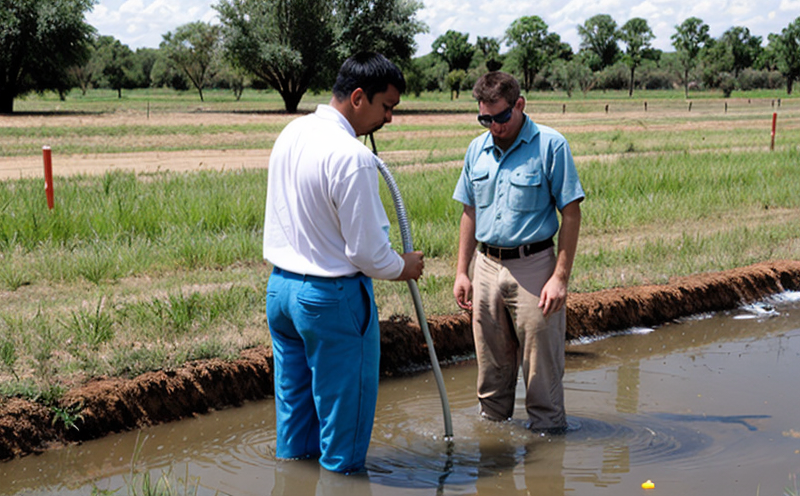EPA 245.1 Mercury by Cold Vapor AAS Test in Groundwater
The EPA 245.1 method for the determination of mercury (Hg) in groundwater using cold vapor atomic absorption spectrometry (CV-AAS) is a critical tool for environmental compliance and water quality assessment. Mercury, particularly methylmercury, poses significant risks to human health and aquatic ecosystems due to its bioaccumulative nature and toxic effects.
The CV-AAS technique leverages the principle that mercury atoms vaporized from the sample interact with light of a specific wavelength, emitting a signal that is directly proportional to the concentration. This method is highly sensitive, allowing for detection limits as low as 0.01 μg/L, making it suitable for groundwater samples which can contain trace amounts of mercury.
The EPA 245.1 protocol specifies sample preparation techniques such as acid digestion or filtration followed by dilution to ensure the sample falls within the linear range of the CV-AAS instrument. The method also dictates the use of reference standards and quality control measures, including spike recovery tests and duplicate analyses.
Accurate and reliable results are essential for regulatory compliance with CWA, which mandates monitoring of mercury in surface water and groundwater to prevent contamination. The protocol is widely used by environmental agencies, drinking water treatment facilities, and research institutions to ensure that the quality standards set forth by regulations like 40 CFR Part 136 are met.
In addition to compliance monitoring, this test serves a variety of industrial applications. For instance, mining operations must regularly assess groundwater near tailing ponds to prevent mercury contamination from leaching into local water bodies. Similarly, municipal utilities conducting wellhead testing for drinking water sources may employ EPA 245.1 to ensure the safety and quality of their supplies.
The CV-AAS method's sensitivity and precision make it a preferred choice over older techniques like cold vapor atomic fluorescence spectrometry (CVAFS), which has higher detection limits and less selectivity for mercury species. The current trend towards more stringent environmental regulations further emphasizes the importance of accurate, reliable mercury testing.
- Advantages:
- Sensitivity to trace levels of mercury
- High precision and accuracy
- Rapid analysis time
- Cost-effective for compliance monitoring
The CV-AAS method's widespread adoption underscores its importance in the environmental sector. By providing accurate measurements of mercury concentrations, it helps industries and municipalities comply with regulatory requirements while also aiding researchers in understanding mercury cycling within aquatic ecosystems.
Applied Standards
EPA Method 245.1 is a recognized standard for determining total mercury in water by CV-AAS. It aligns closely with other international standards such as ISO and IEC, which provide additional validation of the method's reliability.
The protocol specifies detailed procedures for sample preparation, including dilution ratios, digestion methods, and quality control measures like duplicate analyses and spike recovery tests. These steps ensure that results are accurate and reproducible, crucial for regulatory compliance and scientific research.
Compliance with EPA 245.1 is mandatory for facilities handling or disposing of mercury-containing waste, as it ensures that environmental impacts are minimized. The method's strict adherence to quality control measures also helps prevent false positives or negatives, which could lead to incorrect regulatory actions.
For research purposes, the method provides consistent results across different laboratories and time periods, allowing for standardized comparison of data from various studies. This uniformity is critical in understanding regional variations in mercury contamination and developing effective mitigation strategies.
Benefits
- Compliance: Ensures regulatory compliance with EPA and other relevant standards.
- Precision: Provides highly accurate measurements of mercury concentrations in groundwater.
- Sensitivity: Detects trace levels of mercury, crucial for identifying potential contamination sources.
- Rapid Analysis: Quick turnaround times support timely decision-making and response to environmental issues.
The ability to detect and quantify mercury in groundwater using EPA Method 245.1 with CV-AAS is essential for maintaining the quality of water resources, protecting public health, and ensuring compliance with stringent environmental regulations.
Industry Applications
EPA Method 245.1 finds extensive application in various industries and sectors:
- Mining: Monitoring groundwater near tailing ponds to prevent mercury contamination.
- Distribution: Assessing drinking water sources for compliance with regulatory standards.
- Research: Studying mercury cycling and environmental impacts in aquatic ecosystems.
The method's versatility and reliability make it a cornerstone of environmental testing, ensuring that industries can meet their sustainability goals while adhering to strict legal requirements.





